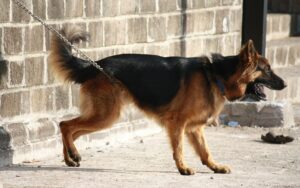Working dog breeds have been important to humans for hundreds of years. Their history goes back to old times when people first used the special skills of some dogs to help with different jobs. Over time, many popular working dog breeds were bred in a certain way to create different types of working dogs.
Table of Contents
Introduction
These breeds have unique traits that make them good at their jobs, which include search and rescue, hunting, and protection. Some of the top working dog breeds are not only very smart and strong, but they are also very dedicated to their jobs and the people who train them.
The History Of Working Dogs
The history of a number of popular working dog breeds can be traced back to ancient civilizations when people first used the skills of dogs for specific jobs. Ancient Egyptian dogs helped them hunt and herd, and Roman army dogs went on military missions. These early working dogs were very important to people, and they set the stage for later breeding and selection.
Working Dog Evolution
People changed the way working dog breeds looked so they could do different jobs by breeding them. Selecting dogs with good traits like intelligence, speed, and stamina made sure that these traits would be passed down to future generations. Through this process, different working dog types with unique skills and personalities have developed.
Recognized Working Dog Types
There are many different types of top working dog breeds today, and each has its own skills and traits. There are several groups for these kinds, such as herding dogs, guard dogs, search and rescue dogs, and others. Some popular working dog breeds are the German Shepherd, the Labrador Retriever, the Border Collie, the Belgian Malinois, the Golden Retriever, the Siberian Husky, the Boxer, and the Rottweiler.
Traits Of Working Dog Breeds
Intelligence
Working dog breeds are known for being smart. They can quickly learn and understand complicated instructions and tasks, which helps them do well in their jobs. Their ability to change and solve problems makes them valuable in many different kinds of jobs.
Physical Strength and Endurance
Many popular working dog breeds are known for their strength and ability to keep going for a long time. These dogs are strong enough to do hard things like pull heavy sleds, herd animals, and help with search and rescue tasks. They are strong, muscular, and have a lot of stamina, which helps them do well in jobs that are hard on the body.
Working dog breeds in action are very agile and athletic, which helps them get around and over a wide range of surfaces and barriers. Their agility and quick reflexes help them do things quickly, whether it’s moving over wreckage during a search and rescue operation or moving livestock in a precise way.
Trainability
Their ability to quickly and correctly follow directions gets them into tough training programs and guarantees that they will be good at their jobs.
Versatility In Different Working Situations
Many top working dog breeds are very good at adapting to different working situations and places. These dogs can do their jobs well no matter where they are or what the weather is like. They can also do their jobs well in both cities and rural places. Their ability to change lets them do well in many different jobs, which makes them important in many different fields.
Bonding And Loyalty Between Humans And Dogs
One of the best things about some of the popular working dog breeds is how loyal and attached they are to the people who train them. Working dogs and their handlers have strong mental bonds because they trust each other and understand each other. This link makes them better able to work as a team because it helps them pick up on their handler’s cues and understand what he or she is trying to do. Working dog breeds are so loyal and dedicated that they are willing to put themselves in danger to protect and help the people they work with.

Popular Working Dog Breeds
The German Shepherd

The German Shepherd is a well-known working dog breed that is known for being smart and able to do a lot of different things. They are very good at things like search and rescue, law enforcement, and military work. Their sharp senses, strong desires to protect, and unwavering loyalty make them great choices for hard jobs.
The Labrador Retriever

Labrador Retrievers are not only popular family pets, but also top working dog breeds. They are often taught to be search and rescue dogs, help dogs for people with disabilities, and dogs that can find explosives. Their smarts and desire to please, along with the fact that they are nice and gentle, make them great people to work with.
The Border Collie

These are small working dog breeds. Border Collies are known for their incredible intelligence and ability to herd. They are great at herding sheep and horses and managing other animals. They are very important on farms and fields because they can pay close attention, move quickly, and anticipate and follow directions quickly.
The Belgian Malinois

The Belgian Malinois is a breed of dog that can do a lot of different things. They are often used as police and military working dogs because they are very strong-willed, smart, and easy to train. Belgian Malinois are great at jobs like tracking, guarding, and search and rescue because they are very active and have strong desires to protect.
Golden Retriever

A Mix of Intelligence, agility, and warmth Golden retrievers are popular family pets and also do well as popular working dog breeds in action. They are often used as guide dogs for the blind, comfort dogs, and search and rescue dogs. Their knowledge and flexibility, along with the fact that they are friendly and patient, make them good candidates for a wide range of jobs.
The Siberian Husky

They are known for their long life and ability to handle hard situations. They have been used as sled dogs for a long time. In the past, they traveled long lengths over snowy ground. Because they are strong, quick, and have thick coats, they can pull heavy loads in cold weather. This makes them the top working dog breeds in the Arctic.
Boxer

Boxers are known for being strong, quick, and very loyal to their families. Even though they are flexible and can do many things well, they are most often seen as service dogs that help people with disabilities and give them emotional support. Boxers are great for these important jobs because they have a lot of energy, are smart, and are friendly.
Rottweiler

They are strong working dog breeds with an instinct to protect. They are often used by the police, for protection, and in search and rescue. Rottweilers are very good at these hard jobs because they are so strong, loyal, and have a natural desire to protect.
Dutch Shepherd
These dogs are Intelligent, loyal, and hardworking. Similar in temperament and ability to the Belgian Malinois. Suitable roles for Dutch shepherds are as military dogs for Detection, patrol, and search and rescue.
Doberman Pinscher

Doberman Pinscher are Alert, energetic, and intelligent. Known for their sleek appearance and protective nature. Roles suitable for Dobermans are Patrol and guard duties.
Giant Schnauzer
These are Strong, intelligent, and protective. Known for their loyalty and working ability. Suitable roles for Giant Schnauzer include Patrol and guard duties.
Alaskan Malamute
These are Strong, independent, and hardworking. Known for their endurance and ability to work in harsh conditions. Suitable roles for alaskan malamute are Sled and pack duties, search and rescue.
Types of Working Dog Breeds in the Field
Heroes in Disaster Zones
They are an important part of search and rescue efforts. Because of their keen sense of smell, agility, and ability to move through rough terrain, they can help find and save people who are lost during natural disasters, avalanches, and other situations. German Shepherd, Labrador Retriever, and Belgian Malinois dogs are often trained for these high-stakes missions, where their special skills and unwavering commitment can mean the difference between life and death.
Police and Military Dogs
They work together to stop crime. Police and military units all over the world use working dog breeds in action to help keep the peace. These dogs have been taught for a long time to do things like catch people, find smells, find bombs, and find drugs. German Shepherds, Belgian Malinois, and Dutch Shepherds are often used for these jobs because they are quick, brave, and good at finding scents. These canine friends help law enforcement agencies do their jobs better by giving them more sense and scaring off potential criminals.
Herding Dogs
Experts at managing livestock herding dogs, like Border Collies and Australian Shepherds, have natural tendencies to the group and do a great job of managing livestock. Farmers and ranchers use these smart, trainable dogs to help them guide and control sheep, cattle, and other wildlife. Their ability to anticipate and respond to commands, along with their ability to stay focused and move quickly, makes them important for herding animals and making sure they are safe and healthy.
Service Dogs
Service dogs help people with disabilities by giving them more freedom and making their lives better. These dogs are taught to do certain things based on what their handlers need. For example, they can lead people who can’t see, warn people who can’t hear, or help people who have trouble moving around. Labrador Retrievers and Golden Retrievers are often chosen for these jobs because they are smart, easy to train, and friendly. Therapy dogs, which are known for being calming and comforting, can bring joy and emotional support to people in hospitals, nursing homes, and other therapeutic places.
Sled Dogs to Survive in the Arctic
Sled dogs have been used in the Arctic for transportation and travel for thousands of years. Siberian Huskies and Alaskan Malamutes are two types of dogs that have been bred to be strong, hardy, and able to pull sleds over long lengths in cold weather. Because these dogs know how to deal with snow and ice, they are essential for movement and logistics in remote and hard-to-reach places.
Guide Dogs
Guide dogs are trained to help people who are blind or have low vision. This gives them a new sense of freedom and independence. These dogs have been trained so well that they can lead their owners safely past barriers, cars, and other dangers. They are picked because they are smart, have a calm personality, and can stay focused even when there are a lot of other things going on. When it comes to training and care for working dog breeds Labrador Retrievers, Golden Retrievers, and German Shepherds are often chosen for guide dog training because they are easy to train and do well in the job.
Therapy dogs
They bring joy and comfort to people who need it. Most of them are small working dog breeds. Therapy dogs play an important role in giving mental support and companionship to people in hospitals, nursing homes, schools, and places where there has been a disaster. People of all ages and backgrounds can get along with these dogs because they are calm and quiet. They make you feel good, reduce stress, and improve your general health. Labrador Retrievers, Golden Retrievers, and Poodles are often chosen because they are friendly and good with people, and they can also form strong bonds with the people they meet. Therapy dogs go through a lot of training to make sure they are well-behaved, flexible, and able to handle a wide range of places and situations.
How to Train and Care for Working Dog Breeds in Action
Socialization and Obedience Training
Working dog breeds need to be socialized early to make sure they behave well and can get along with other people. Getting them used to different places, people, animals, and situations from a young age helps them become well-rounded and bold. They need to follow their handlers’ commands quickly and reliably, so obedience training is very important.
Working dog breeds in action needs both physical and mental exercise on a daily basis to stay stimulated and in top shape. Daily exercise, like quick walks, runs, or activities like agility training or herding exercises, helps them get rid of excess energy and avoid bad behavior. Puzzle toys, obedience training, interactive games, and much other training and care for working dog breeds keep their thoughts sharp and prevent them from getting bored
Note: There might be affiliate links mentioned here. We may receive a commission if you purchase a product through an affiliate link. There is no additional charge for you. Please do your own research before making any online purchases.
Proper Nutrition
Working dog breeds need a well-balanced meal full of nutrients to keep their health and energy levels up. It is important to give your dog high-quality food that meets all of its nutritional needs. A vet should be consulted to figure out what the dog should eat based on its age, amount of activity, and specific needs.
Grooming and Health Care
Regular grooming is needed to keep working dogs clean, comfortable, and free of skin problems or infections. As part of their regular care, they should have their fur brushed, their nails trimmed, their ears cleaned, and their teeth brushed. They need regular vaccinations, checkups, and preventive treatments to ensure their health and well-being as a whole.
Building a Strong Bond
Working dog breeds and their owners need to have a strong bond in order to communicate well and work as a team. Positive reinforcement training and care for working dog breeds, along with fair and regular treatment, help build trust and a strong relationship. The connection between the dog and the handler gets stronger through interaction, play, and friendly gestures, which makes for a good working relationship.
Considerations and Problems
Possible Behavior Problems
Working dog breeds are known for their high levels of energy and drive, which can cause problems if they are not properly directed. To keep their pets from getting bored and doing bad things, owners must give them enough physical and mental exercise. These problems can be lessened by giving them regular exercise, training, and ways to use their natural abilities.
Matching Breed Traits to Jobs
Working dogs have their own strengths and weaknesses that make them better fit for different jobs. Small working dog breeds will do better at some jobs than huge dogs, and vice-versa. To be successful, it is important to match the traits of the breed to the needs of the job. Breeds that are good at herding, for example, are good at managing animals, while breeds that are good at finding scents are good for search and rescue or detection work. To help them find good work, it’s important to know what their natural skills and habits are.
Balancing Work and Family Life
If you own a working dog breed in action, you need to think carefully about how much time and work it will take to meet its needs. These dogs need a lot of mental and physical stimulation and do best when they have a job. It is important to find a good mix between work and giving the dog the care and attention it needs. The owners of the top working dog breeds must be ready to spend time training, exercising, and bonding with their dogs to make sure they are happy and healthy.
Possible Health Problems
Working dog breeds may be more likely to have certain health problems because of their genes or the physical needs of their jobs. For example, hip dysplasia can affect big dogs like German Shepherds, while eye problems can affect Siberian Huskies and even small working dog breeds. Regular visits to the vet, a good diet, and preventive care can help handle and manage these breed-specific health risks, ensuring that the dog will be healthy and live a long life.
Enough Room and Environment
Working dog breeds often need enough room and a good place to live in order to do well. For example, herding dogs may benefit from having a big, fenced-in yard where they can run around and teach their instincts to herd. It is important to make a living space that meets the needs of each breed and keeps them safe and healthy.
Professional Training and Care for Working Dog Breeds
In some jobs, like police or military work, you may need specialized training and expert handling. Working dog breeds that are good for these tasks usually go through long training programs run by skilled professionals. It is important to get help from skilled trainers and managers who can give the dog the skills it needs to reach its full potential and make sure it stays safe and does its job well.
Cost of training and maintaining a work dog
| Dog Breed | Role | Training Cost (USD) | Annual Maintenance Cost (USD) |
|---|---|---|---|
| German Shepherd | Detection, Patrol | $20,000 – $40,000 | $1,500 – $3,000 |
| Belgian Malinois | Detection, Special Ops | $20,000 – $40,000 | $1,500 – $3,000 |
| Labrador Retriever | Detection, Search & Rescue | $10,000 – $20,000 | $1,200 – $2,500 |
| Dutch Shepherd | Detection, Patrol | $20,000 – $40,000 | $1,500 – $3,000 |
| Rottweiler | Patrol, Guard | $15,000 – $30,000 | $1,500 – $3,000 |
| Boxer | Messenger, Patrol | $10,000 – $20,000 | $1,200 – $2,500 |
| Doberman Pinscher | Patrol, Guard | $15,000 – $30,000 | $1,500 – $3,000 |
| Giant Schnauzer | Patrol, Guard | $15,000 – $30,000 | $1,500 – $3,000 |
| Alaskan Malamute | Sled, Search & Rescue | $10,000 – $20,000 | $1,200 – $2,500 |
| Airedale Terrier | Messenger, Detection | $10,000 – $20,000 | $1,200 – $2,500 |
| Bloodhound | Search & Rescue, Tracking | $10,000 – $20,000 | $1,200 – $2,500 |
| Mastiff | Guard | $15,000 – $30,000 | $1,500 – $3,000 |
Conclusion
Working dog breeds have been around for a long time and continue to help people in many important ways. They are very helpful in search and rescue, law enforcement, herding, aid, and therapy work because they are smart, strong, devoted, and dedicated. Each breed, from the flexible German Shepherd to the calm Labrador Retriever and the quick Border Collie, has its own skills and traits that help it do its job.
To care for and work with working dog breeds well, you need to understand their unique needs, give them the right training, exercise, and food, and build a strong relationship with them built on trust and respect. Working dogs can satisfy their natural desire to work and make important gifts to society by putting their natural skills and energy to good use.
Working dog breeds are not only good at what they do, but they are also a lot of fun and a great company for the people who take care of them. Their dedication and commitment make them more than just work partners. They become valuable family members who make the lives of those who are lucky enough to work with them better.
FAQs
What are service dogs?
Working dogs are dogs that have been carefully bred and taught to help people do specific jobs. They have unique traits and skills that make them good for a wide range of jobs, like search and rescue, herding, defense, and helping.
How were working dog breeds developed?
Working dog breeds were made by mixing dogs that were good at their jobs. People knew that different dogs had different traits, so they carefully bred dogs with desirable traits like intelligence, strength, and energy. Through this process, different types of working dogs with different skills and personalities were made.
Can you tell me about some old dogs that worked?
Dogs were important to old societies because they were used for work. For example, ancient Egyptian dogs helped with hunting and herding, while Roman war dogs were used in military operations. These early working dogs were very important to people, and they set the stage for later breeding and selection.
How do you know if a dog breed is a working dog?
Working dog breeds are different in a number of ways:
• Intelligence: They are very smart and learn quickly, which helps them do well in the jobs they are given.
• Physical strength and endurance: No matter if they are huge or small working dog breeds, they are physically able to do hard jobs over and over again.
• Agility and athleticism: They are very agile and have quick reactions, which help them get around in tough places.
• Easy to train: They want to please their masters and do their jobs well.
• Adaptability: They can work in a range of places and under different conditions.
• Loyalty and bonding: They are loyal to their owners and form strong bonds with them.
What are some of the most popular working dog breeds?
Some of the top working dog breeds that are known are:
- German Shepherd
- Labrador Retriever
- Border Collies
- Malinois de Bruxelles
- Golden Doodle
- Siberian Huskies
- Boxer
- Rottweiler
What are the most popular breeds of dogs that work?
These are some of the most common working dog breeds:
- German Shepherd
- Labrador Retriever
- Border Collies
- Malinois de Bruxelles
- Golden Doodle
- Siberian Huskies
- Boxer
- Rottweiler
What are some of the jobs or duties that working dog breeds have?
Working dog breeds have many jobs, including:
• Dogs that find and save people
• Police dogs and service dogs
• Herding pets
• Assistance pets
• Sled dogs
• Guide dogs
How do people train and take care of working dogs?
Working dogs need to be socialized early on, learn obedience, be physically and mentally active often, get the right food, be groomed, and get regular medical care. It is also important for their success that they form a strong bond with their handlers through teaching methods that use positive reinforcement.
What are some problems and things to think about when you own working dog breeds?
Some challenges and things to think about are dealing with high energy and drive, giving the training and care for working dog breed that matches the breed’s traits, balancing work and family life, addressing breed-specific health concerns, giving enough space and environment, and getting professional training and handling specialized roles.
How do working dog breeds make the world a better place?
Working dogs help people by helping with search and rescue, keeping the peace, taking care of livestock, helping people with disabilities, doing therapy work, and getting people around in rough terrain. Their skills and desire to help make them great partners for humans.












